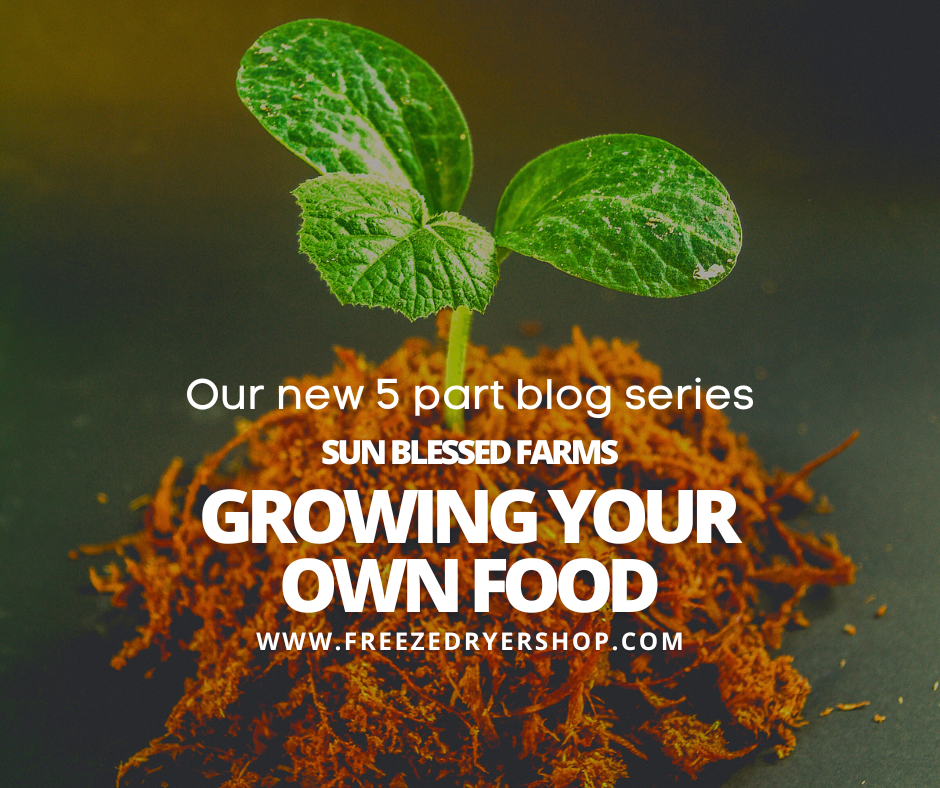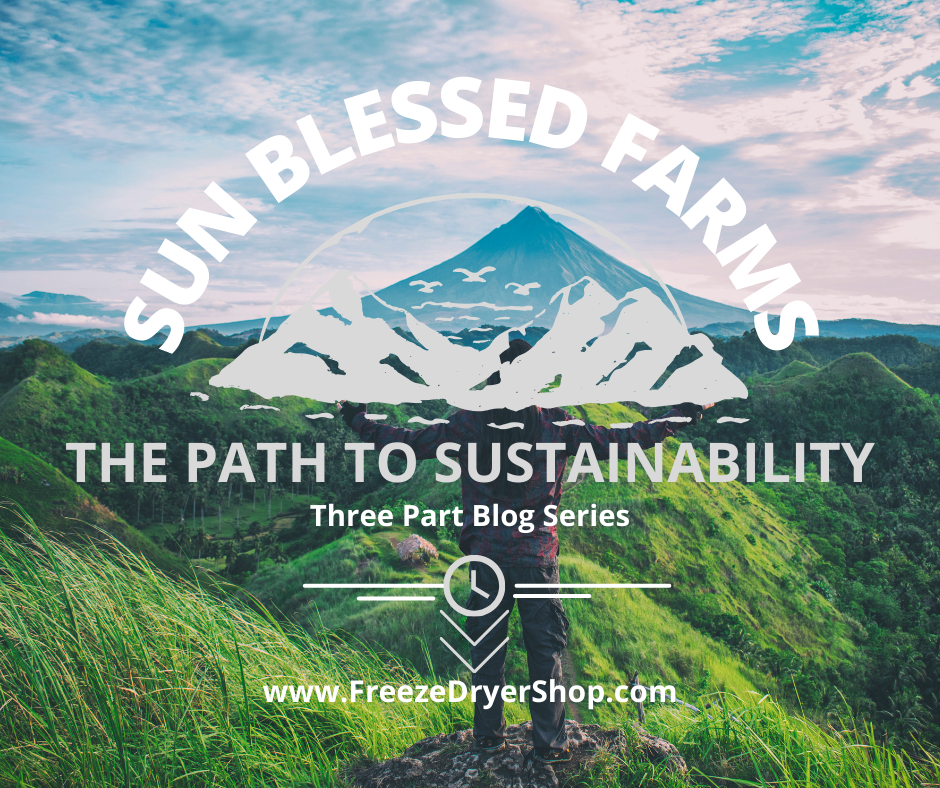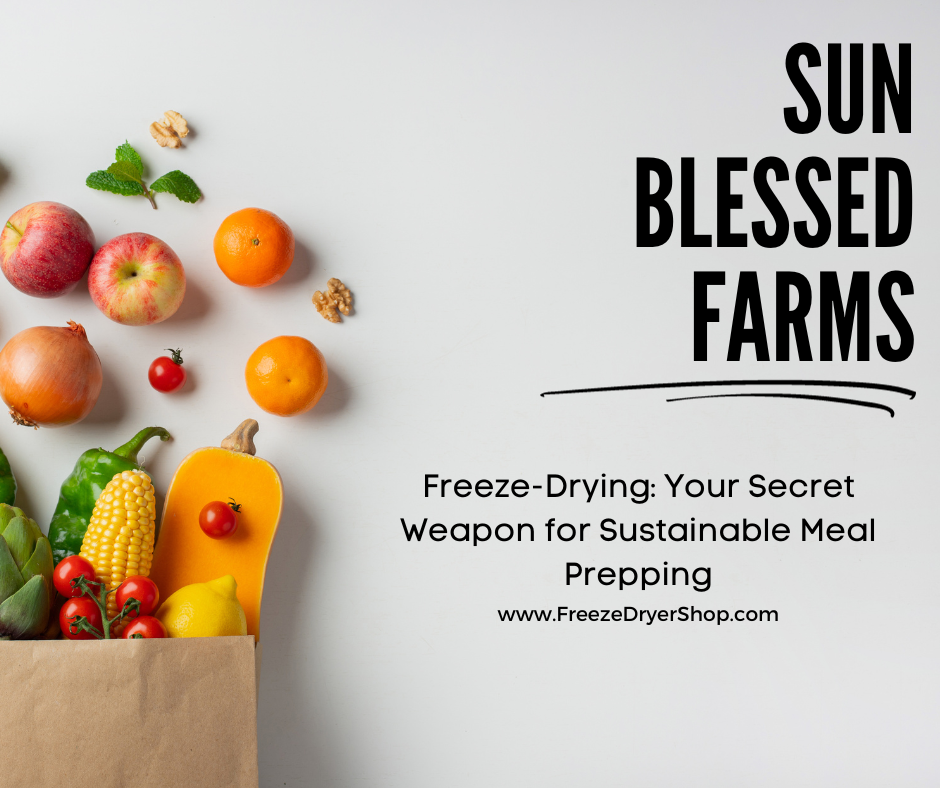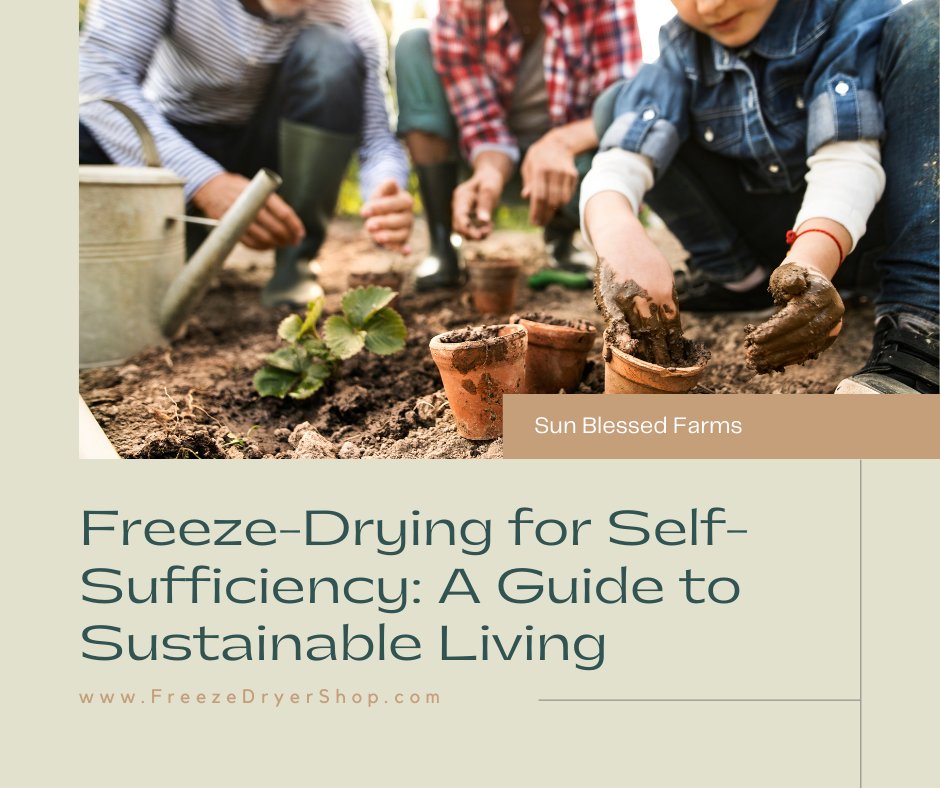Free Shipping to the lower 48 on all freeze dryers!

Please expect up to 4-6 weeks for your order to ship.
Growing Your Own Food Part 2
Composting 101: Turning Kitchen Scraps Into Garden Gold
Composting 101: Turning Kitchen Scraps Into Garden Gold
Welcome to "Composting 101," your comprehensive guide to the art and science of composting. Whether you're an avid gardener looking to enrich your soil, a sustainability enthusiast aiming to reduce waste, or a newbie curious about the magic of composting, this series is designed to demystify the process and help you turn kitchen scraps into nutrient-rich garden gold.
Composting is more than just a green trend; it's a natural, eco-friendly way to recycle organic matter and create a valuable resource for your garden. In this series, we'll delve deep into the world of composting, exploring its benefits, techniques, troubleshooting tips, and much more.
Why Compost?
Before we dig into the nitty-gritty of composting, let's explore why it's such a valuable practice. Compost is often referred to as "black gold" for a reason. It's a nutrient-rich soil conditioner that improves soil structure, enhances moisture retention, and fosters a thriving ecosystem of beneficial microorganisms. By composting, you'll reduce kitchen waste, decrease your environmental footprint, and grow healthier, more productive plants – a win-win for you and the planet.
What to Expect
In this series, we'll cover the basics of composting, including:
- Composting Fundamentals: We'll start with the essentials, breaking down the key ingredients for successful composting and explaining the science behind the process.
- Getting Started: Whether you have a spacious backyard or a small balcony, we'll guide you on choosing the right composting system that fits your space and needs.
- Composting Techniques: Learn the do's and don'ts of composting, from proper layering to managing moisture and aeration.
- Troubleshooting: We'll address common composting challenges and provide solutions to keep your compost pile healthy and odor-free.
- Harvesting and Using Compost: Discover how to know when your compost is ready, and explore the many ways to use it in your garden.
By the end of this series, you'll be equipped with the knowledge and confidence to embark on your composting journey. So, grab your gardening gloves and get ready to transform your kitchen scraps into a valuable resource that nurtures your plants and the environment.
Composting Fundamentals: Unlocking the Magic of Decomposition
At its core, composting is nature's way of recycling organic matter and harnessing the power of decomposition to create nutrient-rich soil. To embark on a successful composting journey, it's crucial to understand the fundamental principles that drive this transformative process.
Key Ingredients: Carbon and Nitrogen
Composting revolves around achieving the right balance of two primary components: carbon-rich "browns" and nitrogen-rich "greens." Browns include materials like dried leaves, straw, and newspaper, while greens consist of kitchen scraps, fresh yard waste, and coffee grounds. This balance is vital because it fuels the activity of beneficial microorganisms responsible for breaking down organic matter.
Carbon provides energy, and nitrogen serves as a protein source for these microorganisms. A C:N (Carbon-to-Nitrogen) ratio of roughly 25-30:1 is ideal. When the mix is too carbon-heavy, decomposition slows down; when it's too nitrogen-heavy, the pile can become smelly and slimy. Achieving this balance is the foundation of successful composting.
The Microbial Workforce
Microbes are the unsung heroes of composting. Bacteria, fungi, and other microorganisms are responsible for breaking down complex organic compounds into simpler forms. As they consume organic matter, they generate heat, which raises the temperature within the compost pile. This heat is a sign that decomposition is happening.
The Importance of Air and Water
Like any living organism, microbes need oxygen and water to thrive. Proper aeration ensures that the compost pile remains aerobic, allowing aerobic bacteria to break down materials efficiently. Turning or aerating the pile regularly helps prevent unpleasant odors and ensures even decomposition.
Water, on the other hand, activates microbes and maintains the right moisture level. Compost should feel like a wrung-out sponge—damp but not soggy. Too much water can lead to anaerobic conditions and a smelly pile, while too little can slow down decomposition.
Understanding these composting fundamentals sets the stage for successful composting.
Getting Started: Different Composting Methods, Finding the Right Fit for You
Composting offers flexibility, and there isn't a one-size-fits-all approach. Depending on your available space, lifestyle, and preferences, you can choose from several composting methods, each with its unique advantages and considerations.
1. Backyard Composting Bins
Backyard composting bins are the go-to choice for many households. These bins are available in various sizes and designs, from traditional open bins to enclosed tumblers. They work well for people with gardens or larger outdoor spaces. Simply collect kitchen scraps, yard waste, and browns, then layer them in your bin. Turn the pile regularly for aeration and decomposition.
2. Vermicomposting
Vermicomposting, or composting with worms, is a fantastic option for those with limited space, like apartment dwellers or urban gardeners. Red wigglers or earthworms are the heroes here. They devour kitchen scraps and turn them into nutrient-rich worm castings. A worm bin can fit discreetly in a closet or on a balcony, making it a compact yet efficient way to recycle organic waste.
3. Trench Composting
Trench composting involves digging a trench in your garden, filling it with organic waste, and covering it with soil. As the materials break down, they enrich the soil directly, providing a natural boost to your plants. This method requires some garden space and is ideal for those who want to improve soil quality while recycling kitchen scraps.
4. Bokashi Composting
Bokashi composting is an anaerobic fermentation process that allows you to compost nearly all food scraps, including meat and dairy. It uses a specialized bran inoculated with beneficial microorganisms to ferment the waste in an airtight container. While it may not produce finished compost directly, the pre-compost created can be buried in the soil or added to a traditional compost bin.
5. Composting Services
In some urban areas, composting services are available. They collect your organic waste, ensuring it's processed into valuable compost. While convenient, this method may come with a fee, but it's a great option for those with limited time or space.
Choosing the right composting method depends on your specific circumstances and goals.
Composting Techniques: Nurturing Nature's Recycling
Composting is a natural process, but there are specific techniques you can employ to make it more efficient and effective. Here, we explore some essential composting techniques that can help you turn organic waste into "black gold" for your garden.
1. Proper Layering:
Composting is all about balance, and layering your materials correctly is key. Start with a layer of browns (carbon-rich materials) like dried leaves, straw, or shredded newspaper. Then, add greens (nitrogen-rich materials) such as kitchen scraps, grass clippings, and fresh plant trimmings. Continue alternating these layers to maintain the right carbon-to-nitrogen ratio. This balance ensures the decomposition process runs smoothly.
2. Aeration:
Oxygen is a crucial element in composting. To provide adequate aeration, turn your compost pile regularly. This allows fresh air to reach the microorganisms responsible for breaking down the organic matter. Oxygen helps prevent unpleasant odors and encourages the decomposition of materials. Use a pitchfork or compost aerator to turn the pile effectively.
3. Moisture Control:
Your compost pile should be as damp as a wrung-out sponge. Too much moisture can lead to a smelly, anaerobic mess, while too little can slow down decomposition. To maintain the right moisture level, add water when necessary, and cover your pile to protect it from heavy rain. Consider using a tarp or a compost bin with a lid to regulate moisture effectively.
4. Particle Size:
Chop or shred larger materials like branches and corn stalks into smaller pieces. Smaller particles break down faster and contribute to a more homogeneous compost mixture. This speeds up the decomposition process and ensures that all components of your pile are working together.
5. Temperature Monitoring:
Compost naturally generates heat as microorganisms break down materials. You can monitor the temperature with a compost thermometer. Aim for a range between 130°F to 160°F (54°C to 71°C). This range promotes efficient decomposition and helps kill weed seeds and pathogens.
6. Compost Bin Selection:
Choosing the right composting bin can simplify the process. Bins provide containment, which helps regulate moisture and temperature. Options range from open-air bins to closed tumblers. Consider your available space and how much compost you plan to produce when selecting a bin.
By mastering these composting techniques, you'll be well on your way to creating nutrient-rich compost for your garden.
Troubleshooting: Navigating Common Composting Challenges
Composting is a rewarding endeavor, but it's not without its challenges. Understanding how to troubleshoot common issues can help you maintain a healthy compost pile and achieve the desired results. Let's explore some troubleshooting tips to address potential problems.
1. Foul Odors:
If your compost pile emits unpleasant odors, it's likely due to an imbalance in the carbon-to-nitrogen ratio or excessive moisture. To combat this issue, add more browns like dried leaves or straw to absorb excess moisture and help restore balance. Ensure proper aeration by turning the pile regularly to introduce oxygen and alleviate odors.
2. Pests and Wildlife:
Unwanted guests like rodents or raccoons can be attracted to your compost pile. To deter them, avoid adding meat, dairy, or oily foods to your compost, as these items can attract pests. Use a secure compost bin or layer kitchen scraps with browns to minimize access. Additionally, consider using wire mesh or fencing to further protect your compost.
3. Slow Decomposition:
If your compost pile isn't breaking down as quickly as expected, it may lack sufficient nitrogen or moisture. Ensure you're adding a balance of greens and browns and maintaining the right moisture level (similar to a wrung-out sponge). Turning the pile regularly also helps accelerate decomposition by providing fresh oxygen to microorganisms.
4. Weed Seeds and Diseases:
Sometimes, compost may contain weed seeds or plant diseases that survive the decomposition process. To mitigate this risk, maintain high temperatures within your compost pile (between 130°F to 160°F or 54°C to 71°C) by optimizing the carbon-to-nitrogen ratio and turning the pile frequently. This high-temperature environment can help kill weed seeds and pathogens.
5. Unfinished Compost:
If your compost doesn't appear fully decomposed when you're ready to use it, sift it through a mesh screen or compost sifter to remove larger, undecomposed materials. The sifted compost can be returned to the pile for further decomposition, while the fine, finished compost can be used in your garden.
6. Invasive Plants or Weeds:
In some cases, seeds from invasive plants or persistent weeds may survive composting. Avoid adding these plants to your pile. If you're concerned about existing weed seeds, consider using a hot composting method, which reaches higher temperatures to destroy seeds and pathogens.
By addressing these common composting challenges with effective troubleshooting techniques, you can maintain a thriving compost pile that produces nutrient-rich compost for your garden. Troubles may arise, but with knowledge and perseverance, you'll overcome them and reap the rewards of sustainable composting practices.
Harvesting and Using Compost: Transforming "Black Gold" into Garden Bliss
Congratulations on your composting journey! After patiently nurturing your compost pile, it's time to reap the rewards of your efforts. In this section, we'll delve into the exciting process of harvesting and utilizing your nutrient-rich compost, often referred to as "black gold" for gardeners.
Harvesting Compost:
- Time to Maturity: Compost is ready to harvest when it has transformed into a dark, crumbly, and earthy-smelling material. Depending on factors like temperature, composting method, and the materials used, this process typically takes anywhere from a few months to a year or more.
- Screening or Sifting: To ensure your compost is free from larger, undecomposed materials or debris, use a mesh screen or compost sifter during the harvesting process. Simply pass the compost through the screen, collecting the fine, finished compost in a container while returning any remaining bits to the pile for further decomposition.
- Storage: Store your harvested compost in a dry, covered container or bin to prevent it from becoming overly moist or leaching nutrients. Proper storage ensures your compost remains in prime condition until you're ready to use it.
Using Compost:
- Soil Amendment: Incorporate your finished compost into garden beds, containers, or raised beds to improve soil structure, fertility, and water retention. Aim for a 1-2 inch layer of compost mixed into the top 6-8 inches of soil. Compost enhances soil aeration and nutrient content, promoting robust plant growth.
- Mulching: Apply a layer of compost as mulch around the base of plants to regulate soil temperature, suppress weeds, and reduce moisture evaporation. Mulching with compost also enriches the soil gradually as it decomposes.
- Compost Tea: Create a nutrient-rich compost tea by steeping compost in water. This liquid fertilizer can be sprayed on plant foliage or poured directly into the soil to boost plant health and vitality.
- Potting Mix:* Blend compost with other potting ingredients to create a custom potting mix for container gardening. It adds valuable nutrients and enhances water retention in containers.
- Seed Starting:* Mix compost with a sterile growing medium for seed starting. Its gentle, nutrient-rich nature provides an ideal environment for young seedlings.
- Top Dressing:* Periodically apply a thin layer of compost to established garden beds to replenish nutrients and maintain soil fertility.
Conclusion:
Embarking on the journey of composting is a remarkable way to contribute to environmental sustainability, reduce waste, and enrich your garden's soil. From selecting the right materials and maintaining a proper balance to troubleshooting and ultimately harvesting your "black gold," composting is a rewarding process.
By practicing mindful composting techniques, you'll not only divert organic waste from landfills but also cultivate nutrient-dense soil that supports healthier, more vibrant plants. Whether you're a seasoned gardener or just beginning, composting is a powerful tool that can enhance your gardening experience and contribute to a greener, more sustainable future.
Remember, the journey doesn't end with one successful compost pile. Continue to hone your composting skills, experiment with different composting methods, and observe the transformative effects of "black gold" on your garden. Happy composting!
#Composting #SustainableGardening #OrganicGardening #GardenCompost #BlackGold #GardenEnrichment #EcoFriendly #ReduceWaste #GardenersDelight #NutrientRichSoil
Ready to work with
Sun Blessed Farms LLC?
Let's connect! We’re here to help.
Send us a message and we’ll be in touch.
Or give us a call today at (208) 944-4488
Agency Contact Form
We will get back to you as soon as possible
Please try again later
More Marketing Tips, Tricks & Tools
Sun Blessed Farms Expert Advice


 Rating
Rating
All Rights Reserved | Copywrited by Sun Blessed Farms LLC



